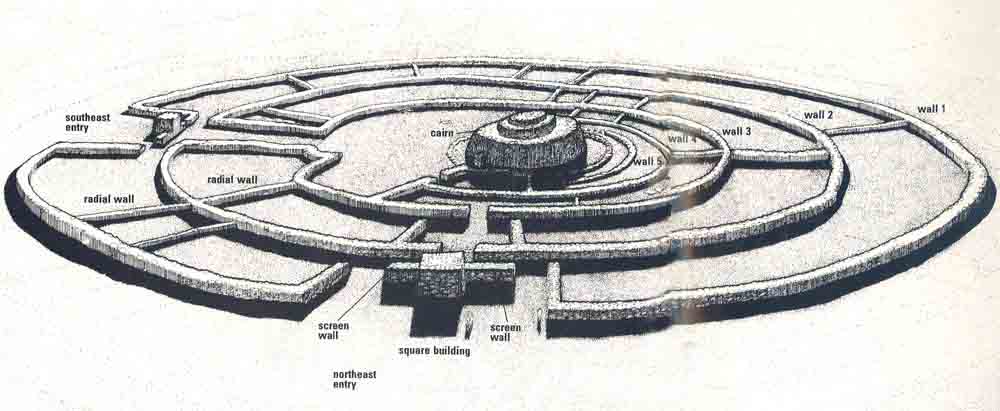RUJM EL-HIRI

Rujm el-Hiri: The Enigmatic Megalithic Site of the Golan Heights
Hidden in the rugged landscapes of the Golan Heights in Syria, Rujm el-Hiri is a monumental megalithic site that captivates archaeologists and historians alike. Known as the “Stone Heap of the Wild Bull,” this ancient structure dates back to the Early Bronze Age and is characterized by its remarkable stone arrangements and intriguing features. As one of the largest and most complex megalithic sites in the region, Rujm el-Hiri invites exploration into the cultural practices and astronomical knowledge of the societies that built it.
An Overview of Rujm el-Hiri

Rujm el-Hiri is composed of a series of large stone constructions, primarily consisting of a central circular cairn surrounded by a series of concentric rings. The site covers an area of approximately 50,000 square meters and features over 40,000 tons of basalt stones. The largest central structure rises about 3 meters high and is surrounded by a circular wall, making it an imposing feature against the backdrop of the Golan Heights.
Historical Context
Dating back to around 3000 BCE, Rujm el-Hiri is believed to have been constructed by the region’s ancient inhabitants, possibly linked to the Canaanites. The site’s strategic location along ancient trade routes indicates that it may have served as a significant cultural and ceremonial center, reflecting the complex social dynamics of its time.
Architectural Features
1. Concentric Circles
The most striking feature of Rujm el-Hiri is its concentric circular layout. The central cairn is surrounded by multiple stone rings, each meticulously constructed with carefully fitted stones. This geometric design not only showcases the builders’ advanced engineering skills but may also symbolize cosmic or spiritual beliefs.
2. Astronomical Alignments
Rujm el-Hiri is notable for its potential astronomical significance. Some researchers suggest that the site may have been used for observing celestial events, with alignments that correspond to solstices and equinoxes. This connection to the cosmos suggests that the ancient builders possessed a sophisticated understanding of astronomy, similar to other megalithic sites worldwide.
3. Burial Practices
The site may also have served as a burial ground, with archaeological evidence indicating that it was used for interring the dead. The presence of numerous tombs and burial structures around the site suggests that Rujm el-Hiri played a vital role in the spiritual and ritualistic practices of its inhabitants.
Cultural Significance
Rujm el-Hiri stands as a testament to the rich cultural heritage of the Golan Heights region. Its construction reflects the societal complexities of ancient communities, highlighting their architectural ingenuity and spiritual beliefs. The site also serves as a symbol of cultural continuity, connecting modern inhabitants to their ancient predecessors.
1. Myth and Legend
Local folklore often intertwines with the history of Rujm el-Hiri, adding layers of meaning to the site. Stories about its origin and significance have been passed down through generations, reinforcing its place in the cultural memory of the region.
2. Preservation Challenges
Despite its significance, Rujm el-Hiri faces threats from natural erosion, urban development, and geopolitical tensions in the region. Efforts to preserve this important archaeological site are crucial for ensuring that future generations can appreciate its historical and cultural value.
Rujm el-Hiri is more than just a collection of stones; it is a window into the lives of the ancient people who once inhabited the Golan Heights. The site’s impressive architecture, potential astronomical alignments, and cultural significance invite us to explore the depths of human creativity and the enduring quest for meaning that transcends time.
As archaeological research continues and modern preservation efforts take shape, Rujm el-Hiri will undoubtedly reveal more of its secrets, shedding light on the complex societies that built this extraordinary megalithic site.
